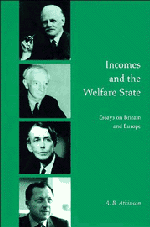Book contents
- Frontmatter
- Contents
- List of figures
- List of tables
- Preface
- Introduction
- I Income inequality and poverty in Britain and Europe
- II Analysis of the Welfare State
- 6 Is the Welfare State necessarily a barrier to economic growth?
- 7 A national minimum? A history of ambiguity in the determination of benefit scales in Britain
- 8 The development of state pensions in the United Kingdom
- 9 Income maintenance for the unemployed in Britain and the response to high unemployment
- 10 Institutional features of unemployment insurance and the working of the labour market
- 11 Social insurance
- III Targeting and the future of social security policy
- Notes
- Bibliography
- Name index
- Subject index
7 - A national minimum? A history of ambiguity in the determination of benefit scales in Britain
Published online by Cambridge University Press: 03 May 2011
- Frontmatter
- Contents
- List of figures
- List of tables
- Preface
- Introduction
- I Income inequality and poverty in Britain and Europe
- II Analysis of the Welfare State
- 6 Is the Welfare State necessarily a barrier to economic growth?
- 7 A national minimum? A history of ambiguity in the determination of benefit scales in Britain
- 8 The development of state pensions in the United Kingdom
- 9 Income maintenance for the unemployed in Britain and the response to high unemployment
- 10 Institutional features of unemployment insurance and the working of the labour market
- 11 Social insurance
- III Targeting and the future of social security policy
- Notes
- Bibliography
- Name index
- Subject index
Summary
The objective of securing a national minimum is a major consideration in the determination of benefit scales. In a social security system dominated by flat-rate benefits, as in Britain, this relation is particularly close. From the choices made about the level of benefits, it may be possible to make deductions about the objectives which lay behind them – a revealed preference argument - and it may be possible to learn from the expressed intentions of governments. The first half of this chapter provides a review of the considerations which appear to have influenced the determination of benefit scales at a national level in Britain. It covers pensions and National Insurance benefits since 1908 and the scales applied in a succession of national means-tested schemes dating from the Unemployment Assistance Board established in 1934.
From this review of the historical record, it is evident that the determination of benefit scales has been characterised more by ambiguity than by clarity. Empson (1953) distinguished Seven Types of Ambiguity; in the treatment in the second half of this chapter I limit myself to three types. First, the decisions made by governments may reflect not just a concern to establish a national minimum but also a balancing of this objective against others, including the reduction of the cost of social security programmes and the avoidance of disincentives. There may be a compromise between different objectives.
- Type
- Chapter
- Information
- Incomes and the Welfare StateEssays on Britain and Europe, pp. 132 - 151Publisher: Cambridge University PressPrint publication year: 1996
- 1
- Cited by



